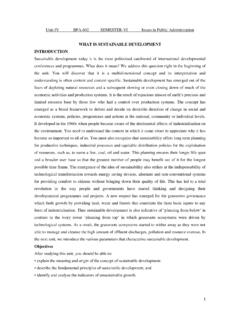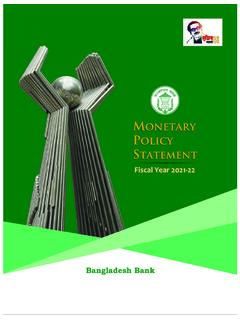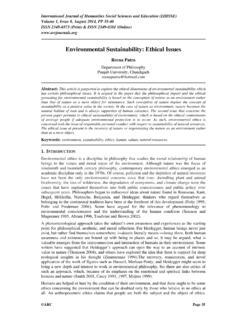Transcription of NATIONAL WATER POLICY (2012)
1 1 Government of India Ministry of WATER Resources NATIONAL WATER POLICY ( 2012 ) 1. PREAMBLE A scarce natural resource, WATER is fundamental to life, livelihood, food security and sustainable development . India has more than 18 % of the world s population, but has only 4% of world s renewable WATER resources and of world s land area. There are further limits on utilizable quantities of WATER owing to uneven distribution over time and space. In addition, there are challenges of frequent floods and droughts in one or the other part of the country. With a growing population and rising needs of a fast developing nation as well as the given indications of the impact of climate change, availability of utilizable WATER will be under further strain in future with the possibility of deepening WATER conflicts among different user groups.
2 Low consciousness about the scarcity of WATER and its life sustaining and economic value results in its mismanagement, wastage, and inefficient use, as also pollution and reduction of flows below minimum ecological needs. In addition, there are inequities in distribution and lack of a unified perspective in planning, management and use of WATER resources. The objective of the NATIONAL WATER POLICY is to take cognizance of the existing situation, to propose a framework for creation of a system of laws and institutions and for a plan of action with a unified NATIONAL perspective. The present scenario of WATER resources and their management in India has given rise to several concerns, important amongst them are; (i) Large parts of India have already become WATER stressed. Rapid growth in demand for WATER due to population growth, urbanization and changing lifestyle pose serious challenges to WATER security.
3 (ii) Issues related to WATER governance have not been addressed adequately. Mismanagement of WATER resources has led to a critical situation in many parts of the country. (iii) There is wide temporal and spatial variation in availability of WATER , which may increase substantially due to a combination of climate change, causing deepening of WATER crisis and incidences of WATER related disasters, , floods, increased erosion and increased frequency of droughts, etc. (iv) Climate change may also increase the sea levels. This may lead to salinity intrusion in ground WATER aquifers / surface waters and increased coastal inundation in coastal regions, adversely impacting habitations, agriculture and industry in such regions. (v) Access to safe WATER for drinking and other domestic needs still continues to be a problem in many areas.
4 Skewed availability of WATER between different regions and different people in the same region and also the intermittent and unreliable WATER supply system has the potential of causing social unrest. 2 (vi) Groundwater, though part of hydrological cycle and a community resource, is still perceived as an individual property and is exploited inequitably and without any consideration to its sustainability leading to its over-exploitation in several areas. (vii) WATER resources projects, though multi-disciplinary with multiple stakeholders, are being planned and implemented in a fragmented manner without giving due consideration to optimum utilization, environment sustainability and holistic benefit to the people. (viii) Inter-regional, inter-State, intra-State, as also inter-sectoral disputes in sharing of WATER , strain relationships and hamper the optimal utilization of WATER through scientific planning on basin/sub-basin basis.
5 (ix) Grossly inadequate maintenance of existing irrigation infrastructure has resulted in wastage and under-utilization of available resources. There is a widening gap between irrigation potential created and utilized. (x) Natural WATER bodies and drainage channels are being encroached upon, and diverted for other purposes. Groundwater recharge zones are often blocked. (xi) Growing pollution of WATER sources, especially through industrial effluents, is affecting the availability of safe WATER besides causing environmental and health hazards. In many parts of the country, large stretches of rivers are both heavily polluted and devoid of flows to support aquatic ecology, cultural needs and aesthetics. (xii) Access to WATER for sanitation and hygiene is an even more serious problem. Inadequate sanitation and lack of sewage treatment are polluting the WATER sources.
6 (xiii) Low consciousness about the overall scarcity and economic value of WATER results in its wastage and inefficient use. (xiv) The lack of adequate trained personnel for scientific planning, utilizing modern techniques and analytical capabilities incorporating information technology constrains good WATER management. (xv) A holistic and inter-disciplinary approach at WATER related problems is missing. (xvi) The public agencies in charge of taking WATER related decisions tend to take these on their own without consultation with stakeholders, often resulting in poor and unreliable service characterized by inequities of various kinds. (xvii) Characteristics of catchment areas of streams, rivers and recharge zones of aquifers are changing as a consequence of land use and land cover changes, affecting WATER resource availability and quality.
7 Public policies on WATER resources need to be governed by certain basic principles, so that there is some commonality in approaches in dealing with planning, development and management of WATER resources. These basic principles are: 3 (i) Planning, development and management of WATER resources need to be governed by common integrated perspective considering local, regional, State and NATIONAL context, having an environmentally sound basis, keeping in view the human, social and economic needs. (ii) Principle of equity and social justice must inform use and allocation of WATER . (iii) Good governance through transparent informed decision making is crucial to the objectives of equity, social justice and sustainability. Meaningful intensive participation, transparency and accountability should guide decision making and regulation of WATER resources.
8 (iv) WATER needs to be managed as a common pool community resource held, by the state, under public trust doctrine to achieve food security, support livelihood, and ensure equitable and sustainable development for all. (v) WATER is essential for sustenance of eco-system, and therefore, minimum ecological needs should be given due consideration. (vi) Safe WATER for drinking and sanitation should be considered as pre-emptive needs, followed by high priority allocation for other basic domestic needs (including needs of animals), achieving food security, supporting sustenance agriculture and minimum eco-system needs. Available WATER , after meeting the above needs, should be allocated in a manner to promote its conservation and efficient use. (vii) All the elements of the WATER cycle, , evapo-transpiration, precipitation, runoff, river, lakes, soil moisture, and ground WATER , sea, etc.
9 , are interdependent and the basic hydrological unit is the river basin, which should be considered as the basic hydrological unit for planning. (viii) Given the limits on enhancing the availability of utilizable WATER resources and increased variability in supplies due to climate change, meeting the future needs will depend more on demand management, and hence, this needs to be given priority, especially through (a) evolving an agricultural system which economizes on WATER use and maximizes value from WATER , and (b) bringing in maximum efficiency in use of WATER and avoiding wastages. (ix) WATER quality and quantity are interlinked and need to be managed in an integrated manner, consistent with broader environmental management approaches inter-alia including the use of economic incentives and penalties to reduce pollution and wastage.
10 (x) The impact of climate change on WATER resources availability must be factored into WATER management related decisions. WATER using activities need to be regulated keeping in mind the local geo climatic and hydrological situation. 4 2. WATER FRAMEWORK LAW There is a need to evolve a NATIONAL Framework Law as an umbrella statement of general principles governing the exercise of legislative and/or executive (or devolved) powers by the Centre, the States and the local governing bodies. This should lead the way for essential legislation on WATER governance in every State of the Union and devolution of necessary authority to the lower tiers of government to deal with the local WATER situation. Such a framework law must recognize WATER not only as a scarce resource but also as a sustainer of life and ecology.







